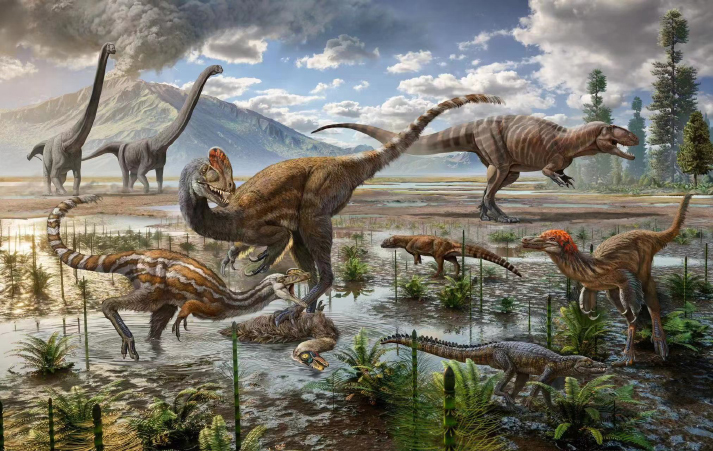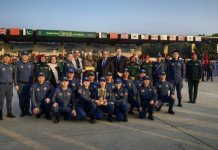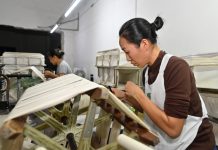
Zhao Chuang is a 43-year-old science artist working in Beijing. The illustrator’s job bridges science and art by painting and sculpting ancient extinct species based on information collected from fossils. Zhao reproduces each element described in paleontological papers in an artistic way, and the blanks in scientific research are filled by his logic and imagination.
Zhao is a dream collaborator for many paleontologists, museums and publishing houses. His painting of a prehistoric flying mammal became the cover of prominent British scientific journal Nature in 2006, a highlight in his career as a science artist. Ten years later, he worked with the American Museum of Natural History on its exhibition focusing on the links between dinosaurs and birds.
The paleo-artist, who has painted over thousands prehistoric animals, is used to creating works at night and often sleeps just four hours a day, going to bed around 6 a.m. and waking up around 10 a.m.
“Recreating those ancient creatures is arduous, and it makes me feel like I’m dealing with 4.6 billion years of life on Earth,” he said, adding he will continue delving into the history of our planet, though painting a full picture of it is an impossible mission.

Boyhood romance
Zhao began by painting dinosaurs as a child. “Do you remember the first time you saw a dinosaur? The first time you see them, it’s like… a miracle.” The lines from the 1997 movie The Lost World: Jurassic Park perfectly describe Zhao’s initial encounter with dinosaurs.
When Zhao was a second-grade student at primary school, his parents bought him a popular Chinese science book series intended for children, One Hundred Thousand Whys.
In the pages describing biological evolution, the boy saw a Tyrannosaurus Rex and was attracted by the introduction about it: It was 15 meters long, weighed 6 tons, lived 88 million years ago and was one of the most powerful animals to ever walk the face of the planet. These figures were accompanied by a simple illustration, but it captivated him.
From that point on, he began reading more about dinosaurs, writing science fiction about them, painting them and even took three years to create his own book popularizing dinosaurs. At that time, his dream was to write a book specifically about the dinosaurs that once lived in China—a dream that was realized last year. Also, at his studio on the outskirts of Beijing, the number of his “dinosaurs” at some points exceeded 100, creating a spectacular sight.
Science and art
In Zhao’s eyes, dinosaurs are elegant. “They have long necks and tails. Their legs are thin… When they walked, the force was transmitted from the feet to the pelvis, and then to the sides of the body, and this balance must have been very beautiful.”
Nearly 20 years have passed, but Zhao still enjoys painting these long-gone creatures. However, he said reading research materials about them is the most time-consuming aspect of his work. Generally, he creates a draft on paper that lays out the dimensions and features of each animal. The next step is to recreate its skeleton and then its muscles.
Today, Zhao can scan the entire bone structure of a dinosaur into a computer and add muscles to it using software. The resulting digital model is printed with 3D printing technology and can be used as a model for painting or as the basis for producing a finished model.
“We draw the muscles and bones of animals following biological principles,” Zhao said, adding many of the ways dinosaurs move in the movies would be impossible in reality.
Next, he creates the model’s skin, which includes adding colors, furs or scales, patterns and textures. This stage requires the artist to make use of his imagination and logic as many fossils fail to provide such details. When illustrating, Zhao often must also recreate the plants and other elements of an animal’s habitat consistent with the period in which it existed before the complicated painting is finally finished.
Zhao has to upgrade or alter details in his drawings and models or even create new works when new scientific discoveries are published.
“Some people have asked me if people like me in the arts hate these figures, principles and rules. No, I like them. They are the content of my creation. What people in science art do is to make this information into a work that makes sense instead of simply pursuing visual effects.”
An ambitious plan
“When I first started painting prehistoric animals, it was a very niche circle in which enthusiasts could only contribute to relevant exhibitions at museums,” Zhao recalled. “But now, more people are interested in this area, which requires us to provide even more authentic recreations of originals.”
So behind Zhao’s own “Jurassic Park” is the constant study of over two decades. He has accumulated a considerable knowledge of specialized vocabulary as most papers on dinosaurs are written in English. Since 2009, he has been joining research institutes in the excavation of fossils in order to better understand the species he recreates. His in-depth studies continue to broaden as he has been expanding his recreations to include more species.
Supported by the latest scientific research, he hopes to demonstrate the inner relationship between species, the natural environment, community, culture and other aspects of their evolution through his artworks. “My endeavor began in 2010 and will focus on telling stories about the lives that have existed on Earth. Dinosaurs are just one branch. These lives also include aquatic reptiles and early humans. I enjoy exploring and drawing the evolution of life,” he said, describing his ambitious career goals.
“Earth is a big laboratory where different life has appeared, many of which were strange looking. Over a long time, some have evolved while the rest have disappeared, and the world eventually became what it is today,” Zhao continued.
He hopes to develop the concept into an exhibition based on his recreations. He plans for the exhibition to focus on two concepts, time and space, which are the principles of Zhao’s creation of science art. “I will select several important animals in history to show the evolution process in different places and at different times,” he said.
“But the centerpiece of the exhibition will be a Tyrannosaurus Rex, whether as a painting or a sculpture. I have loved it since I was a child and it drew me into this profession,” he explained, adding it has to be a 1:1-scale reproduction so that visitors can realize what a magnificent animal this was. –The Daily Mail-Beijing Review news exchange item





